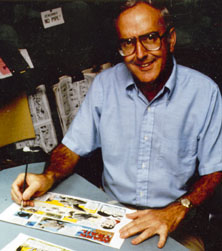| Revision as of 15:46, 22 May 2011 editDMacks (talk | contribs)Edit filter managers, Autopatrolled, Administrators186,633 edits →External links: rm supercat of the existing cats← Previous edit | Revision as of 19:37, 26 May 2011 edit undoHrkent22 (talk | contribs)1 edit →External linksNext edit → | ||
| Line 69: | Line 69: | ||
| * | * | ||
| * | * | ||
| * | |||
| ] | ] | ||
Revision as of 19:37, 26 May 2011
A cartoonist is a person who specializes in drawing cartoons. Much of this work is humorous, usually created for entertainment, political commentary or advertising. Throughout the 20th century, cartoons were widely published in print media of various kinds, featured in magazines such as The New Yorker and Punch and distributed to newspapers through such organizations as King Features Syndicate. Today, both original cartoons and vintage cartoons can be found online.
Cartoonists may work in many different formats: single-panel gag cartoons, editorial cartoons, comic strips, comic books, graphic novels, video game packaging, booklets, manuals or animation. A cartoonist traditionally developed rough sketches into finished pencil drawings and then, for reproduction purposes, completed the artwork in black India ink, using either a brush or a metal-nibbed pen. Many favored a Winsor & Newton #3, Series 7 brush used in combination with a crowquill pen.
Today, cartoonists increasingly work in digital media. To illustrate the Blondie comic strip, the cartoonist John Marshall works directly on a Wacom tablet connected to his Macintosh computer.
History
The English satirist and editorial cartoonist William Hogarth, who emerged In the 18th century, has been credited with pioneering Western sequential art. His work ranged from realistic portraiture to comic strip-like series of pictures called "modern moral subjects". Much of his work poked fun at contemporary politics and customs; illustrations in such style are often referred to as "Hogarthian".
During the 20th century, numerous magazines carried single-panel gag cartoons by such freelance cartoonists as Charles Addams, Irwin Caplan, Chon Day, Clyde Lamb and John Norment. These were almost always published in black and white, although Collier's often carried cartoons in color. The debut of Playboy introduced full-page color cartoons by Jack Cole, Eldon Dedini and others. Single-panel cartoonists syndicated to newspapers included Dave Breger, Hank Ketcham, George Lichty, Fred Neher, Irving Phillips and J. R. Williams.
Comics
Comic strips received widespread distribution to mainstream newspapers by syndicates such as the Universal Press Syndicate, United Media or King Features. Sunday strips go to a coloring company such as American Color before they are published.
Some comic strip creators publish in the alternative press or on the Internet. Comic strip artists may also sometimes work in book-length form, creating graphic novels. Both vintage and current strips receive reprints in book collections.
The major comic book publishers (such as Marvel or DC) utilize teams of cartoonists to produce the art (typically separating pencil work, inking and lettering while the color is added digitally by colorists). When a consistent artistic style is wanted among different cartoonists (such as Archie Comics), character model sheets may be used as reference.
Calum MacKenzie, in his preface to the exhibition catalog, The Scottish Cartoonists (Glasgow Print Studio Gallery, 1979) defined the selection criteria:
- The difference between a cartoonist and an illustrator was the same as the difference between a comedian and a comedy actor—the former both deliver their own lines and take full responsibility for them, the latter could always hide behind the fact that it was not his entire creation.
Animation
Animated cartooning is created for short films, advertising, feature films and television. It is also sometimes used in live-action films for dream sequences or opening titles. An animation artist is commonly referred to as an animator rather than a cartoonist.
Books and exhibitions
There are many books of cartoons in both paperback and hardcover, notably the collections of cartoons from The New Yorker. Prior to the 1960s, cartoons were mostly ignored by museums and art galleries. In 1968, the cartoonist and comedian Roger Price opened the first New York City gallery devoted exclusively to cartoons, mainly work by the leading magazine gag cartoonists. Today, there are several museums devoted to cartoons, notably the Billy Ireland Cartoon Library & Museum, run by curator Jenny E. Robb at Ohio State University.
Societies and organizations

- The Cartoonists' Guild
- National Cartoonists Society
- Association of American Editorial Cartoonists
- Society of Illustrators
- Society of Children’s Book Writers and Illustrators
- San Francisco Society of Illustrators
- Society of Illustrators of Los Angeles
- The Association of Illustrators
- The Illustrators Partnership of America
- AIIQ - l’Association des Illustrateurs et Illustratrices du Québec
- Colorado Alliance of Illustrators
- The Association Archaeological Illustrators and Surveyors
- Guild of Natural Science Illustrators
- Guild of Natural Science Illustrators-Northwest
- Illustrators Australia
Communities
References
- The British Museum. Beer Street, William Hogarth - Fine Art Print Retrieved 11 April 2010.
- "The Comics Reporter". Retrieved 17 November 2009.
- MacKenzie, Calum. The Scottish Cartoonists. Glasgow Print Studio Gallery, 1979.